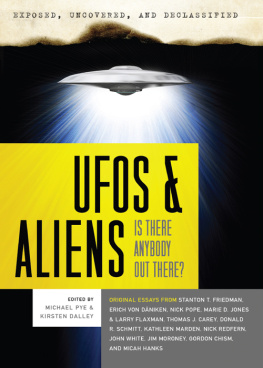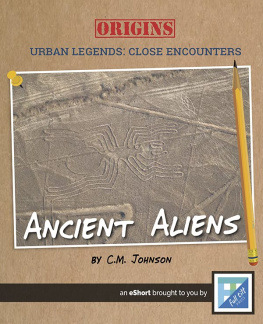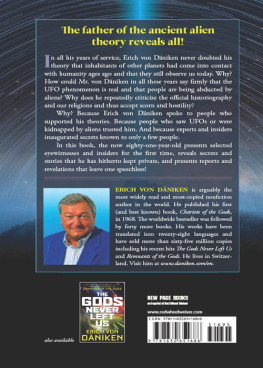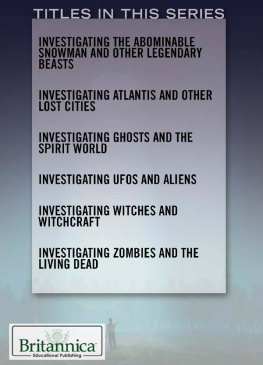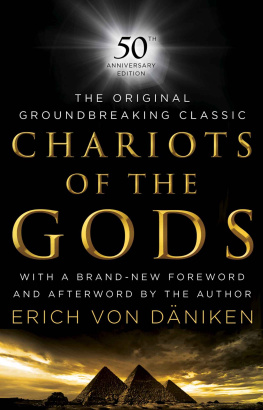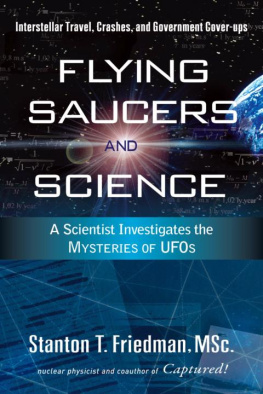

Copyright 2011 by Michael Pye and Kirsten Dalley
All rights reserved under the Pan-American and International Copyright Conventions. This book may not be reproduced, in whole or in part, in any form or by any means electronic or mechanical, including photocopying, recording, or by any information storage and retrieval system now known or hereafter invented, without written permission from the publisher, The Career Press.
EXPOSED, UNCOVERED, AND DECLASSIFIED: UFOS & ALIENS
EDITED BY KIRSTEN DALLEY
TYPESET BY DIANA GHAZZAWI
Cover design by Ian Shimkoviak/the BookDesigners
Printed in the U.S.A.
To order this title, please call toll-free 1-800-CAREER-1 (NJ and Canada: 201-848-0310) to order using VISA or MasterCard, or for further information on books from Career Press.

The Career Press, Inc.
220 West Parkway, Unit 12
Pompton Plains, NJ 07444
www.careerpress.com
www.newpagebooks.com
Library of Congress Cataloging-in-Publication Data
CIP Data Available Upon Request
www.redwheelweiser.com
www.redwheelweiser.com/newsletter
Contents
Preface
From ancient times up until today, mysterious objects in the sky and reports of visitors from the stars have captured our attention. Brief mentions of such otherworldly events appear in texts as old as the Bible, in ancient drawings and architecture, and even in famous paintings depicting scenes that most would consider straight out of science fiction. The number of modern sightings has continued to grow exponentially. Even if there is only a whisper of truth to these accounts, they are worth our scrutiny and investigation. Some cases have mountains of evidence that cannot easily be dismissed.
Our main reason for compiling this volume was to further ignite discussioneven disagreementso that everyonebelievers and skeptics alikecan get the answers they've been looking for. UFO researchers can hardly be considered fringe nowadays, although some would insist on using that term. Many of the contributors to this volume are hard scientists who have braved the censure and rejection of their peers to boldly go where no-one else has gone (no-one else in their field, at least). The fact is that ufology has now entered the mainstream, and the people who are currently investigating UFOs and accounts of alien visitation bring a healthy dose of much-needed skepticism to their inquiry. For these researchers, the need for truth overrides the desire to believe.
Governments all over the world have admitted that they've held back information pertaining to these matters. Some of this information has slowly made its way out into the world. The British government recently released more than 8,000 documents that had previously been classified and sequestered far from the public eye. And a 1950 memo addressed to J. Edgar Hoover was recently released by the FBI, which seems to provide irrefutable proof that aliens crash landed in Roswell. The question still remains, however, of how many of these important documents were destroyed, and what, if anything, is still being held back.
Gathered here are completely original essays that run the gamut of the UFO phenomenoneverything from the familiar (Roswell and Kingman) to thedare we say it?more alien (the ancient aliens theory and parallel universes). Whether you agree with any of the findings or not, these contributions are sure to pique your curiosity and challenge your credulity. It is our belief that there is more to the world than what has already been given the stamp of approval by academia and orthodox science.
The truth is out there. Whether or not you are willing to find it, is up to you.
Michael Pye and Kirsten Dalley
March 30, 2011
A Cosmic Watergate UFO Secrecy
By Stanton T. Friedman
I learned long ago, as a young nuclear physicist working on classified advanced nuclear systems in industry, that a key step in determining the truth about any situation is asking the right question(s). With regard to the question of whether important information about flying saucers is currently being withheld from the public, the question is definitely not Can governments, such as that of the United States, keep secrets for many decades? Governments don't keep secrets. Individuals and the organizations they work for keep secrets. The question then becomes Can government-funded organizations and the people who work for them keep secrets? The answer is a very definitive yes. That said, there are three major factors that must be present in order for these individuals and organizations to keep secrets:
1. The need to know is crucial. To gain access to classified documents, e-mails, reports, equipment, and/or facilities, one must have a need to know. Mere curiosity, scientific or otherwise, is not enough.
2. Security clearances are needed, which are only awarded after detailed background investigations. Depending on the level of clearance involved, this can include an investigation of relatives and friends, as well. What's more, having a Secret clearance at a particular facility that gives you access to particular documents or equipment does not necessarily provide you access to other similarly classified documents that are not covered by the need to know.
3. There must be an infrastructure that supports and enables this secret-keeping. There have to be facility clearances and approved storage facilities (usually with fireproof combination safes) for the storage of classified documents. Fences, guards, identification for all employees, recognition devices, and so on are also required. Again, having access to one part of a facility doesn't necessarily mean access to all parts. There will also be paper trails consisting of signed security documents, security briefings, and so on. Reinvestigations are often required periodically, such as every five years, which will also be documented. Classified documents are typically inventoried every year, as well.
There are many examples of large-scale classified projects involving thousands of people, all of which were able to be kept secret from the general populaceand often even from the very people working on these projects. The classic example is the Manhattan Engineering District, established early on during WWII to develop nuclear weapons. At one time as many as 60,000 people were involved at many different locations. The K-25 Gaseous Diffusion Facility at Oak Ridge National Laboratory in Tennessee, for example, was a mile long and was using 5 percent of all the electricity produced in the United States to pump gaseous uranium hexafluoride through tiny holes in metal barriers (this was to gradually enrich the gas in the lighter uranium isotope, U-235, a necessary component of nuclear weapons). Workers were instructed to turn a handle when the dial showed a certain value. Due to the security measures that had been put into place, many workers had no idea what it was they were working on.
A number of other similar large and expensive facilities were built, including the Los Alamos National Laboratory (LANL) in New Mexico, Sandia Laboratories in Albuquerque, New Mexico, Lawrence Livermore Labs in Northern California, and Hanford Works in eastern Washington State. Less than 10 years ago, each facility employed more than 8,000 people and had an annual budget of more than a billion dollars. The total annual budget for the first three facilities combined was more than $3 billion, which exceeded the total budget of the National Science Foundation for all its research projects put together. During the war these were the so-called black programs. Their very existence was classified. The LANL employed outstanding scientists, including Nobel Prize winners; all received their mail at a post office box in Santa Fe. Vice-President Harry Truman was completely unaware of the project until 13 days after the death of President Roosevelt on April 12, 1945. Once he was sworn in as president, he had to be briefed about the program in order to make crucial decisions regarding its use.
Next page
